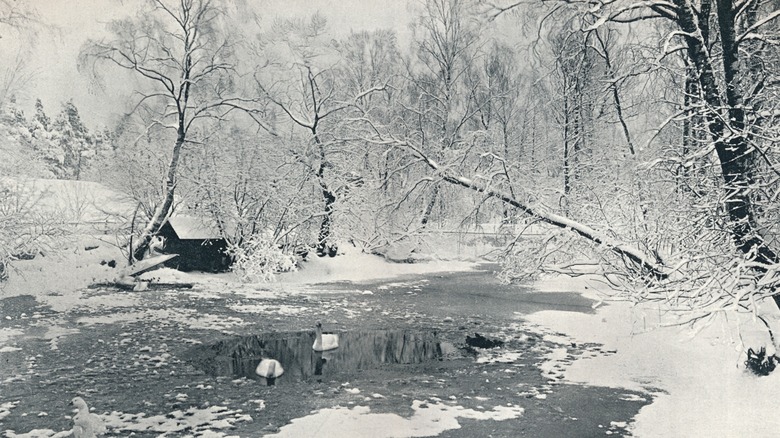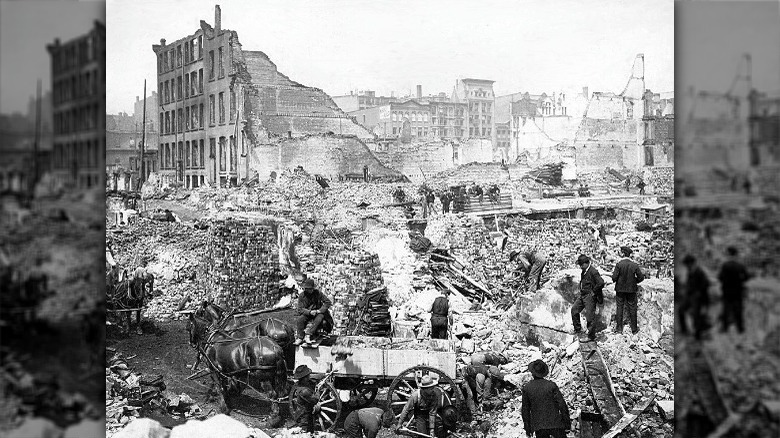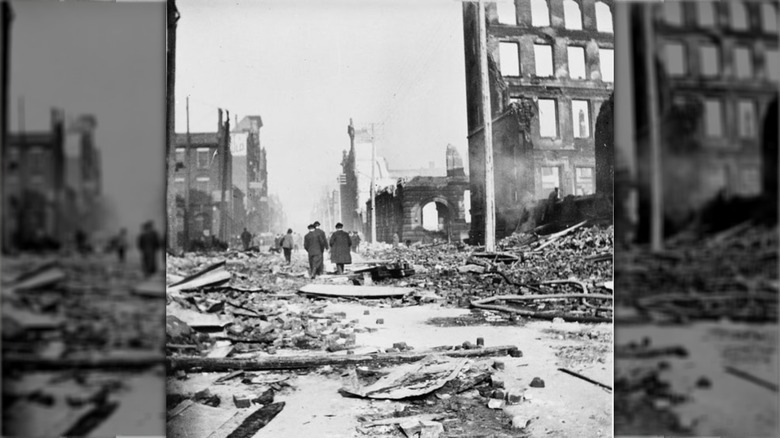The Tragic Story Of The Great Fire Of Toronto
Think about Victorian London for a second: the towering buildings climbing up the skyline, the factories springing up, rapid industrialization, new technology (and a decent helping of exacerbating societal issues). Well, as explained by the Toronto History Museums, you can basically take that image and superimpose it onto Toronto around the same point in time. Industry was becoming king in order to keep up with growing needs for materials in order to placate the spreading desire for new technologies, from railways to telephones to electric lights. Architecture benefitted from all those materials, too, with buildings climbing quite a few stories higher than they ever could have in the past – the Canadian Encyclopedia mentions that the 1890s and 1900s specifically saw quite the surge in construction – all while more and more people flocked to the cities.
But all wasn't quite as well as it might have seemed on the surface. In reality, Toronto had needed to rebuild and readjust after a massive fire in 1849 (via Toronto.com), and all of that sudden urbanization meant that, in the interest of saving time and money, some corners had to be cut. Unfortunately, by taking a few shortcuts, on April 19, 1904, the city of Toronto found itself in the midst of a tragedy – a very similar tragedy – barely 50 years after much of the city had burned down. Once again, the city found itself smoldering in the aftermath of the Great Fire of Toronto.
It all started on a chilly day (and that made it all the worse)
Naturally, thinking of fire conjures up the vivid, terrifying sensation of burning, of extreme and unbearable heat. But in the case of the Great Fire of 1904, the day itself couldn't be further from that sort of description.
As related by the Ontario Ministry of Government and Consumer Services, the fire was first noticed around 8 p.m. on the fairly quiet evening of April 19. The streets were just about empty by that point, which is pretty fitting. After all, temperatures were well below freezing that night, and the winds were more than a little intense – to the tune of about 30 mph, in fact. So, all that taken together, it's probably not much of a surprise that it was snowing by that point, too.
But even if it seems like that frigid weather should've done something to counteract the fire once it started, well, it turned out that the opposite was true. According to the Canadian Encyclopedia, once firefighters were on the scene, the cold temperatures and high winds really fought against them. Not only did the winds spread the fire, but they also meant that any attempts to douse the flames with water were completely foiled, the winds scattering the spray thoroughly enough that it actually showered both the firefighters as well as the mess of exposed telephone wires (which were already causing problems themselves). And even worse? That water started to freeze in the cold air. So not only did that make this whole situation even more physically uncomfortable, but the newly formed ice also managed to down those telephone wires. No calls were getting in or out of the city, at least not easily.
The city desperately needed help
As the fire began to rage, it became more and more obvious that the city of Toronto was nowhere near well-equipped enough to deal with a catastrophe of this scale, even with everyone mobilizing to do their part (via the Canadian Encyclopedia). As told by the Toronto Public Library, firefighters in the area didn't have the tools they needed to contain the fire on their own, working with very few fire trucks and equipment that just wasn't going to cut it.
So they called in the cavalry, and a decent number of neighboring cities answered that call for help. Hundreds of firefighters from a handful of other Canadian cities rode in on the railroad to help douse the flames, bringing with them thousands of feet of higher quality hoses and various other equipment.
But it wasn't just Canadian cities that sent reinforcements into Toronto. According to the Weather Network, this fire was absolutely massive – so massive, in fact, that it could be seen from all the way in Buffalo, New York. Given that sort of scope, American firefighters were also dispatched to provide what assistance they could. With aid coming from multiple different cities (and two different countries), the fire was eventually put out, though that didn't happen until some 9 hours after it'd first been noticed.
Toronto's citizens pitched in where they could
While there was a massive, heroic effort from the firefighters to control the flames, they actually weren't the only people fighting to save the city from a fiery end. Entire other cities mobilized their own forces to help save Toronto (via the Toronto Public Library), but Toronto itself did quite the same, with normal, everyday people taking risks to save what they could.
A couple of stories, in particular, a worth knowing about. In one instance, employees of the Evening Telegram newspaper stuck around, throwing any water they could get their hands on out the window. The Canadian Encyclopedia also adds that they were further armed with a bunch of wet towels, which were used effectively as shields against the intense heat.
And aside from that? There was also the case of the Queen's Hotel (via the Ontario Ministry of Government and Consumer Services). In much the same vein, employees stayed in the building, doing whatever they could to try (decently successfully, in fact) and save it from the worst of the fire damage. The techniques themselves were pretty simple, but really quite effective: filling up buckets and bathtubs with water or just hanging a bunch of wet towels over the windows. By doing so, the building never fully caught fire, save a few parts of the roof; the flames were kept almost completely at bay.
Huge parts of the city were affected
Spurred on by no shortage of combustible materials (via the Canadian Encyclopedia), tall buildings designed perfectly to help spread a flame, and violent wind that helped that flame jump from building to building (via the National Research Council of Canada), the fire that rampaged through Toronto in 1904 ate through the city in no time whatsoever. With how quickly it spread, it only makes sense that the footprint left by this fire is absolutely massive.
Nearly 100 different buildings were damaged over the course of the night; all told, about 20 acres of the city were turned to ash. Even then, though, the damage wasn't entirely done, with a number of smaller fires cropping back up over the next couple of days, sputtering out of ruins that continued to smolder for multiple weeks.
And if the numbers aren't quite doing it for you, well, the City of Toronto also provides a map that shows the extent of the fire (pictured above), which had managed to spread in all directions, jumping across a number of fairly wide streets and severely damaging whole blocks in one fell swoop.
The city was left in ruins
Even though you can quantify the losses that the city felt by looking at areas affected or amounts of money lost, there's something viscerally sad about just looking at the photos documenting the destruction. The City of Toronto itself provides quite a few of those photos, and all of them are, well, eerie, to say the least.
In those photos, you just see the ruins of an absolutely decimated city. Charred, blackened husks of buildings stand out against a starkly bright sky as smoke still seems to swirl around the city streets. No walls are left entirely intact, most of them in varying stages of crumbling to the ground. Dirt and planks and bricks lay in mounds along the streets as telephone wires tangle and drop to the ground. And comparisons of the same street before and after the fire only make the destruction all the more apparent; beautiful, towering buildings that line busy streets are suddenly, completely gone, looking more like facades than actual buildings. A paper approved by the National Research Council of Canada goes into further detail, painting a scene that sounds even more apocalyptic, complete with exposed steel beams, left standing but twisted, sticking out of the rubble.
The financial losses were massive
While Toronto was a growing urban center in the late 19th century and early 20th century, the Canadian Encyclopedia also goes further to say that it had a core that was heavily centered on industrial pursuits. And this was the particular section of the city that was hit by the Great Fire. So losses? There were definitely a lot of those.
While just under 100 buildings were ultimately damaged by the fire, there wasn't an equal number of businesses that were also damaged by the same event. On the contrary, there were quite a few more – something closer to 220 businesses that called those buildings home. More specifically, the fire found its way to some of the warehouses of these companies, some of which dealt in products like stationery or processes like bookbinding, according to the National Research Council of Canada. (That said, a lot of other kinds of warehouses and businesses were also affected, ranging from clothing to machinery to pharmaceuticals.) Anything combustible was destroyed, and in some cases, there was little – or nothing – that could be recovered or salvaged. All told, insurance on the destroyed goods totaled over $8 million on its own, and the property damages soared even higher than that – above $10 million, in fact.
And the effects weren't only felt by the businesses and those at their heads. It all rippled out to everyday people, 6,000 of whom suddenly found themselves without jobs.
Was anyone hurt?
With a fire this huge, causing massive financial losses and basically razing an entire city to the ground, leaving it a charred shell of its former self, you'd think that there had to be some sort of massive death toll to accompany the event, right? Well, fortunately, the Great Fire of Toronto isn't one of those cases. In all, there's actually only one death that's attributed to this event.
Of course, that's not to say that everyone got out unscathed; that's not true at all. The National Research Council of Canada report cites 25 injuries total, though other sources, such as The Star, only mention a total of five. As explained by the City of Toronto, most of those injuries were relatively minor, often amounting to temporary damage to some firefighters' eyes due to exposure to the smoke. The most extreme injury was actually suffered by the fire chief himself, who broke his leg after taking a tumble off of a ladder.
So then, what was this one death? That came in the late aftermath of the fire, according to the Toronto Public Library. On May 4, John Croft was working at the site of one of the damaged buildings, demolishing it before the city could begin to rebuild in earnest. That job required some explosives, and given that, maybe you can see where this is going. He planted a number of sticks of dynamite and waited for them to go off, except not all of them actually did. Heading over to examine the faulty dynamite, Croft ended up finding that the fuse was just slow (via the Canadian Encyclopedia). It exploded right in front of him, and he died of his injuries the next morning.
What directly caused the fire?
Given the damages caused by the fire, you'd think there would be some sort of consensus as to how it got started, right? Surely the authorities would go searching for an answer as to what happened and name a culprit, wouldn't they?
Well, things are nowhere near that simple, in actuality. Because here's the truth: no one knows exactly what caused this fire. There's speculation, of course. The Canadian Encyclopedia posits a couple of simple theories; the culprit could have just been something as simple as an unfortunate incident with a stove or heater (everyone's familiar with the fear of leaving the stove on, right?) A Globe and Mail article from April 21, 1904 (via Toronto Public Library) provides a different possibility: badly insulated electric wires. According to the Ontario Ministry of Government and Consumer Services, that particular theory holds quite a bit of water. The recent inventions of the telephone and the telegraph meant that the Toronto skyline was crisscrossed with a bunch of exposed wires, after all, and those wires would continue to pose fire hazards for at least another decade.
Maybe the fire was inevitable
While it's always interesting to wonder what exactly it was that immediately caused this catastrophe, in all honesty, the real truth might be that the fire was just a tragedy waiting to happen.
According to the Canadian Encyclopedia, the economic boom that had hit the city in the years immediately prior led to spectacular growth when it came to the skyline, but in the midst of that prosperity, safety wasn't exactly at the forefront of anyone's agenda. Quite literally – money just wasn't being invested in safety. The buildings themselves were terribly prone to catching fire, made largely of wood with roofs covered in tar (just another flammable thing to add to the mix). And if a fire did start, then the actual design of the buildings meant that it wouldn't be hard for flames to spread, both up and down floors (via Ontario Ministry of Government and Consumer Services) as well as between separate buildings.
But it didn't end there. Because in case of a fire, the city at large didn't really have any way to deal with it. Most buildings didn't have a sprinkler system; for that matter, a vote three years prior showed that many people didn't even want to install the kind of water system necessary to support those sprinklers anyway. And firefighters just couldn't protect the city with the resources they had; all of Toronto had only five fire trucks – less than a third of Montreal's number. Only a week earlier, Toronto's fire chief at the time summed up the precarious situation the best, saying, "We are taking more and more risks every year; we are running in wonderful luck."
Public officials finally took fire safety more seriously
A disaster like the Great Fire of Toronto is always met by some sort of reaction from those in charge. After all, given that the real root cause behind the fire itself was, in effect, general neglect and disregard for safety (via the Canadian Encyclopedia), it only makes sense. In short, the fire made the city of Toronto realize just how important fire safety was, pushing them to do better in the future.
What followed the fire was a whole slew of reforms. A 1905 vote led to the approval of new, high-pressure water systems to be installed throughout the city (which would actually be effective four years later in 1909, according to the Ontario Ministry of Government and Consumer Services). Sprinkler systems – which had only been present in a few buildings prior to the fire – became a common feature and were integrated such that they could function even on the upper stories of taller buildings. Per the Toronto Public Library, those systems cost the city some $1 million and were accompanied by a much larger budget set aside for more firefighters and better equipment.
Even the way buildings were constructed began to change. Rather than wooden being used for supports, concrete and steel became among the most prominent of building materials, and floorplans were designed to include features like fire doors and firewalls, even in those buildings that did manage to survive. After all, the city had learned its lesson; there was no reason not to err on the side of caution.










